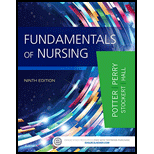
Concept explainers
To determine:
Ms. Cavallo, 97 years of age, has been a resident at the rehabilitation unit for 6 weeks. She has been receiving rehabilitation therapy following the repair of her fractured left hip. The nursing assistive personnel (NAP) tells you that Ms. Cavallo has not been finishing her meals over the past 2 days because of poor appetite. As you enter her room with a food tray today, she stares, “Go away and take that tray of food with you. I’m tired of all of this, and I just want to stay in bed today.” You explore why she feels this way. You discover that she does not like the foods that are being prepared for her and she does not feel strong enough to get out of bed and use my walker.
On the basis of these data, you develop a nursing diagnosis of deficient knowledge related to lack of information. Identify one goal, two expected outcomes, and three related nursing interventions with rationales that will help her meet the identified goal and outcomes.
Concept introduction:
Ms. Cavallo, 97 years old women who repair her left hip fracture and resident for 6 weeks in a rehabilitation unit. She didn’t take meals over 2 days because of poor appetite. She told to the nursing assistive personnel that she is tired and wants to stay in bed. The nursing assistive personal feels the patient feel tried and fear to use a walker.
Explanation of Solution
The older patient needs a walker to avoid immobility because it causes serious side effects to the patient. This is assessed by the staff nurse and identify one goal, two expected outcomes and three nursing interventions with rationales that will help to meet the identified outcomes and goals.
Goal: Ms. Cavallo obtains benefits of mobility using a walker after hearing teaching session of the nurse.
Expected outcomes:
- 1. Physical therapy helps Ms. Cavallo to agree with mobility using a walker.
- 2. Increased using of walker would reduce the fear of falling.
Interventions:
- 1. The nursing staff should teach the benefits of a walker and aids her to have physical therapy work with the use of a walker. Reinforcement and interdisciplinary approach should improve the skill accomplishment and retention of learning.
- 2. The fear of Ms. Cavallo is allowed to express although it is a non-judgemental manner. In older adults, the loss of independence and falling fear is most serious problems. Trust could maintain between the patient and the nurse by allowing the fear to express so that it could improve the learning process.
- 3. Nursing staff should discuss the dangers of immobility such as pneumonia, decreased physical endurance and skin breakdown so that she prevent them from happening. This helps the older patient to take care of themselves and it ensures the independence of the patient.
Ms. Cavallo encourages by the nurse to express her fear to the nurse to learn the hazards of immobility. The nurse should provide information about the benefits of using a walker.
Want to see more full solutions like this?
Chapter 28 Solutions
Fundamentals of Nursing, 9e
- explain an abdominal exam?arrow_forwardDiscuss β -Lactam antibiotics under the following subheadings Classifications of penicillins Classification of Cephalosporins General Mechanism of Actions Clinical Indications of penicillins and cephalosporins Adverse effects of β-lactamsarrow_forwarda. Define neoplasm b. Differentiate between benign and malignant tumours c. Describe the molecular basis of cancerarrow_forward
- differentiate the extra heart sounds S3,S4, murmurs and gallopsarrow_forward• Define shock and list types of shock • Discuss pathogenesis of septic shock. • Enumerate the stages of shock. • Define oedema and describe the pathophysiologic mechanisms of oedema with examples.arrow_forwardDiscuss Hypertension under the following headings: Definition Diagnosis Non-pharmacological intervention Drugs Classification Management of a Hypertensive emergencyarrow_forward
- Explain how the answer could be 2 or 1.8 WITHOUT changing the questionarrow_forwardoverview of the neurological system, cranial nerves and what part of the body it innervatesarrow_forwarddifferentiate structure and function of the peripheral vascular system. what are the normal and abnormal findings of the peripheral arterioles and peripheral venous systemarrow_forward
 Phlebotomy EssentialsNursingISBN:9781451194524Author:Ruth McCall, Cathee M. Tankersley MT(ASCP)Publisher:JONES+BARTLETT PUBLISHERS, INC.
Phlebotomy EssentialsNursingISBN:9781451194524Author:Ruth McCall, Cathee M. Tankersley MT(ASCP)Publisher:JONES+BARTLETT PUBLISHERS, INC. Gould's Pathophysiology for the Health Profession...NursingISBN:9780323414425Author:Robert J Hubert BSPublisher:Saunders
Gould's Pathophysiology for the Health Profession...NursingISBN:9780323414425Author:Robert J Hubert BSPublisher:Saunders Fundamentals Of NursingNursingISBN:9781496362179Author:Taylor, Carol (carol R.), LYNN, Pamela (pamela Barbara), Bartlett, Jennifer L.Publisher:Wolters Kluwer,
Fundamentals Of NursingNursingISBN:9781496362179Author:Taylor, Carol (carol R.), LYNN, Pamela (pamela Barbara), Bartlett, Jennifer L.Publisher:Wolters Kluwer, Fundamentals of Nursing, 9eNursingISBN:9780323327404Author:Patricia A. Potter RN MSN PhD FAAN, Anne Griffin Perry RN EdD FAAN, Patricia Stockert RN BSN MS PhD, Amy Hall RN BSN MS PhD CNEPublisher:Elsevier Science
Fundamentals of Nursing, 9eNursingISBN:9780323327404Author:Patricia A. Potter RN MSN PhD FAAN, Anne Griffin Perry RN EdD FAAN, Patricia Stockert RN BSN MS PhD, Amy Hall RN BSN MS PhD CNEPublisher:Elsevier Science Study Guide for Gould's Pathophysiology for the H...NursingISBN:9780323414142Author:Hubert BS, Robert J; VanMeter PhD, Karin C.Publisher:Saunders
Study Guide for Gould's Pathophysiology for the H...NursingISBN:9780323414142Author:Hubert BS, Robert J; VanMeter PhD, Karin C.Publisher:Saunders Issues and Ethics in the Helping Professions (Min...NursingISBN:9781337406291Author:Gerald Corey, Marianne Schneider Corey, Cindy CoreyPublisher:Cengage Learning
Issues and Ethics in the Helping Professions (Min...NursingISBN:9781337406291Author:Gerald Corey, Marianne Schneider Corey, Cindy CoreyPublisher:Cengage Learning





